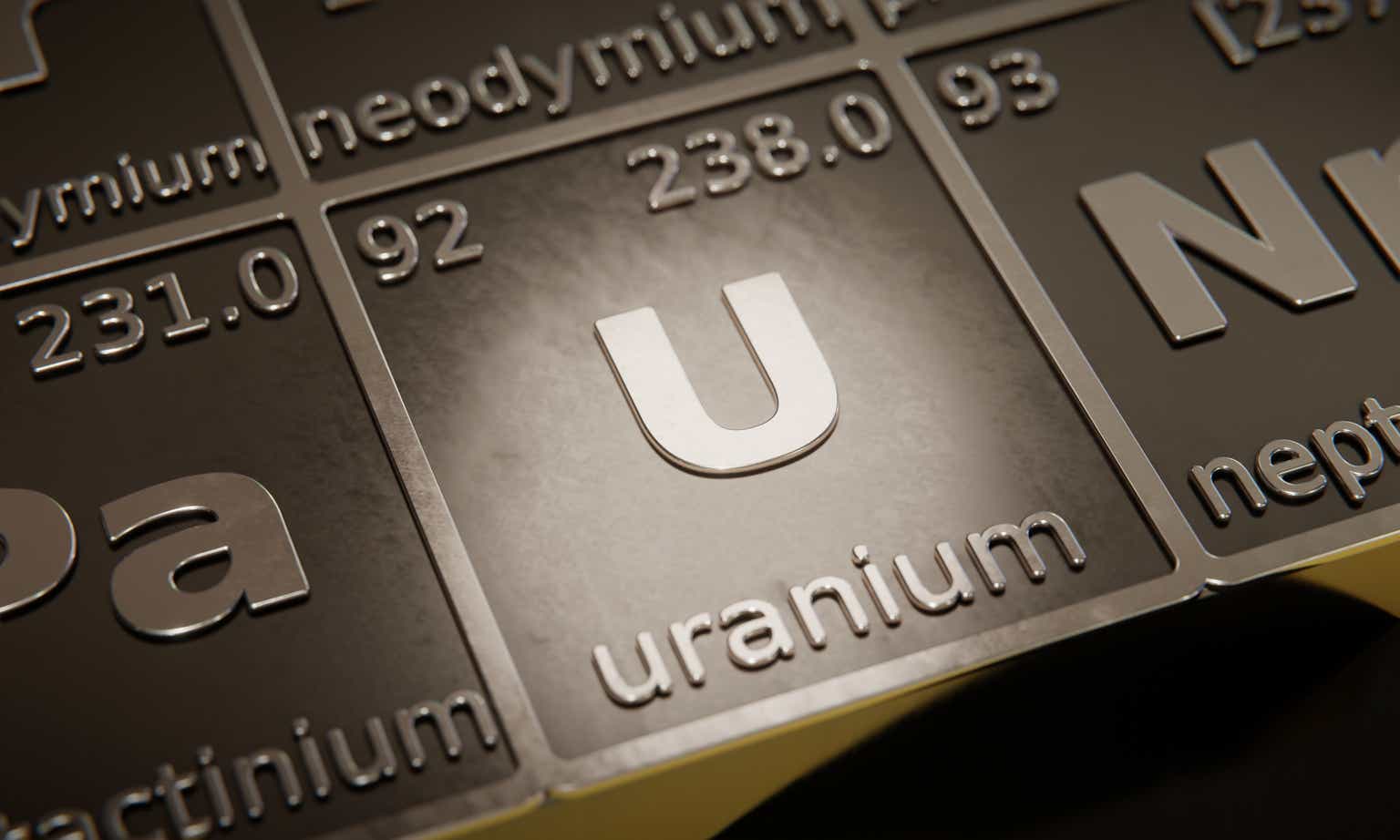It has been a few months since I last wrote about the Global X Uranium ETF (NYSEARCA:URA) and nuclear energy in general. So I thought it would be timely to update my thoughts on the sector and provide an update on any relevant industry news that may have investment implications.
Brief Fund Overview
Before diving into the update, it may be a good idea to provide a brief overview of the URA ETF for those new to the story. The URA ETF tracks the Solactive Global Uranium & Nuclear Components Total Return Index (“Index”), an index focused on the extraction, refining, exploration and manufacturing of equipment for the uranium and nuclear industries. The URA ETF is one of the largest uranium-focused investment vehicles with $1.5 billion in AUM and charges a 0.69% expense ratio.
The URA ETF is a fairly concentrated fund, with the top 10 holdings comprising 65% of the fund’s assets, and the top 3 holdings accounting for almost 40% (Figure 1).
Figure 1 – URA top 10 holdings (globalxetfs.com)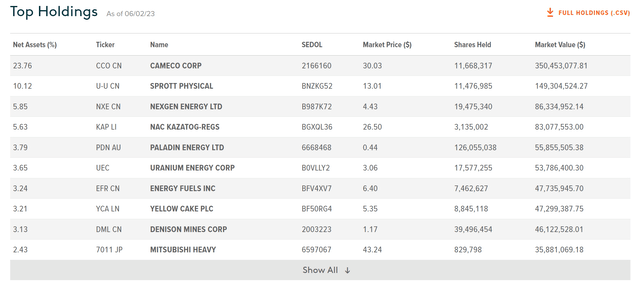
The URA ETF offers a mix of exposures to the nuclear power supply chain through uranium miners, mining explorers and developers, nuclear power component manufacturers, and physical uranium trusts.
Governments Continue to Embrace Nuclear Power
As I wrote in my prior articles, the energy transition to low-carbon sources is structural and governments around the world continue to slowly wake up to the fact that nuclear energy may be a crucial piece of the puzzle to reduce global carbon emissions.
Since my December update, we saw Belgium extend the life of two nuclear reactors for 10 years – a U-turn in policy, as previously, Belgium was slated for a complete nuclear phase-out by 2025. Sweden also proposed laws to enable new nuclear reactor construction, reversing the government’s stance towards reactor closures in the past few years. In France, the government is spearheading an effort to form a coalition of pro-nuclear countries in EU energy talks. One idea championed by France is to generate nuclear-produced hydrogen as a way to reduce carbon emissions for Europe’s heavy industries.
Over in Asia, we saw South Korea pushing to increase nuclear power in its total energy mix from 24% to 33% by 2030. While in Japan, the government announced plans to allow nuclear companies to operate reactors beyond the prior 40-year limit.
Finally in North America, the Biden administration provided $1.2 billion in aid to distressed nuclear power plants, including those recently shut, and the Vogtle nuclear reactor unit 3 in Georgia became the first U.S. reactor to start up in the past 7 years. Recently, the U.S. Senate also advanced a bill that would fast-track the deployment of a new fleet of advanced modular reactors.
Uranium Prices At One-Year Highs
With respect to the physical commodity, Uranium (U3O8) is recently trading at a one-year high (Figure 2).
Figure 2 – Uranium is trading at a 1-yr high (tradingeconomics.com)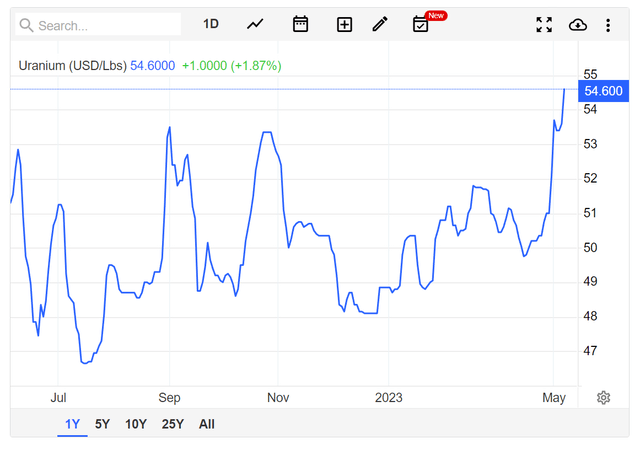
This is in stark contrast to other energy fuels like crude oil and natural gas, which are trading near 1-year lows due to concerns about the global economy and an inventory glut respectively (Figure 3).
Figure 3 – In contrast to crude oil, which is trading near 1-year lows (tradingeconomics.com)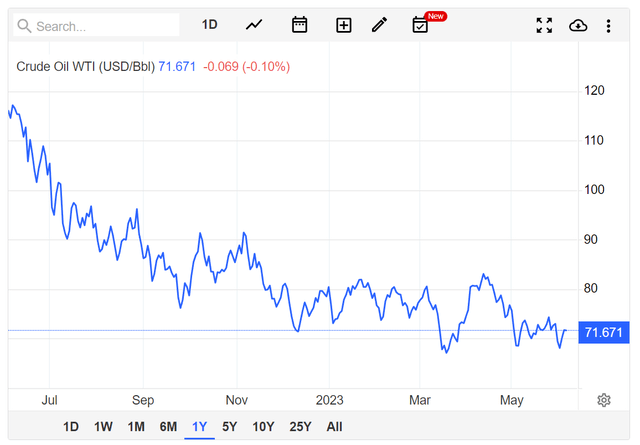
What could be the driver behind uranium’s recent price surge?
New Entrant In Physical Uranium
I believe a big part of the recent surge in uranium prices can be attributed to the launch of the Zuri-Invest Actively Managed Certificates (“Uranium AMC”) on physical uranium. Going through the investment product’s website, these AMCs are similar in setup to ETFs like the Sprott Physical Uranium Trust (OTCPK:SRUUF). They provide investors with a convenient investment vehicle to invest in physical uranium, with Cameco Corporation (CCJ) providing custody for the Uranium AMC.
While there is no definitive figure on the amount raised so far for the Uranium AMC, some industry watchers have speculated that the Uranium AMC may be looking to raise upwards of US$100 million. The timing of the raise for the Uranium AMCs coincides with the recent surge in uranium prices seen in Figure 2 above.
Can Uranium AMC Spark Next Leg Up In Uranium Prices?
Investors may recall that the current uranium bull market kicked into high gear when the Sprott Asset Management took over management of Uranium Participation Corp (Sprott Physical Uranium Trust was formerly known as UPC) in July 2021 and launched a US$300 million at-the-market (“ATM”) equity program in August 2021 to raise new capital and acquire physical uranium assets (Figure 4).
Figure 4 – SRUFF kickstarted uranium bull market (Author created with data from SRUFF website and tradingeconomics.com)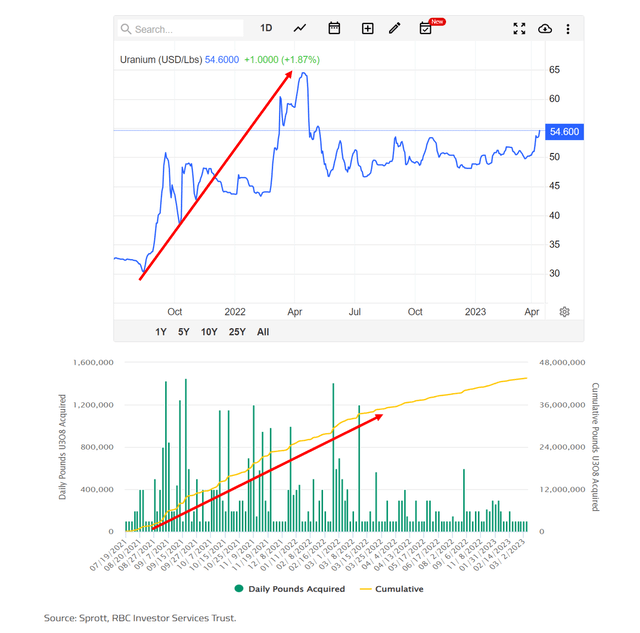
Altogether, SRUUF has raised more than US$2 billion to invest in physical uranium, helping to squeeze uranium prices from $30 to over $65 (Figure 5).
Figure 5 – SRUFF raised more than $2 billion to invest in physical uranium (Sprott Inc company reports)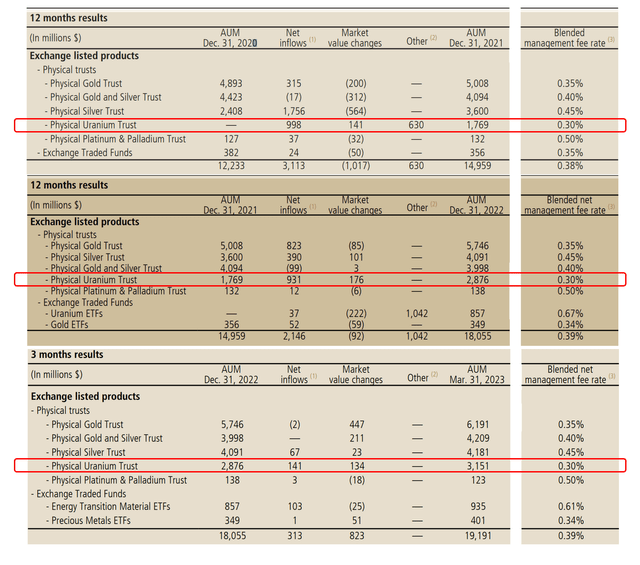
However, uranium’s upward price momentum died off in April 2022 as SRUUF was denied a U.S. listing by the NYSE and SRUUF’s equity issuance momentum slowed down dramatically.
With a new entrant in the physical uranium space converting investor demand into physical demand for uranium, we could see renewed price momentum in the commodity, which could spur more interest in uranium and related investments, creating a virtuous cycle that can spark the next leg higher in uranium prices.
Technicals Heating Up; Watch For Breakout Above $24
Technically, the $18.50 level continues to provide major support to the URA ETF while the ETF consolidates within the broad range that has been in place since late 2021 (Figure 6).
Figure 6 – URA continues to consolidate sideways; watch for breakout above $24 (Author created with price charts from stockcharts.com)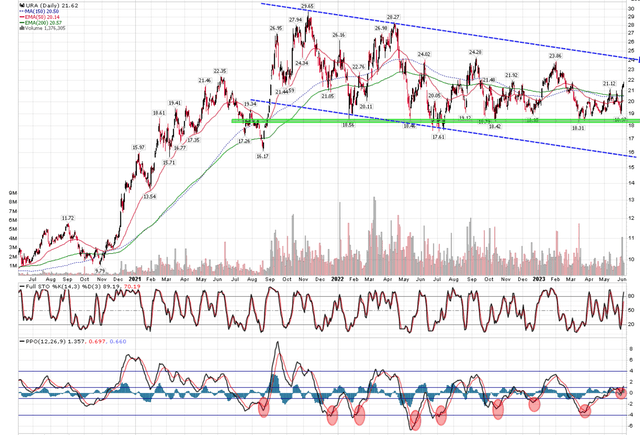
With physical uranium prices recently breaking out to 1-Yr highs, I believe the URA ETF will follow suit shortly and challenge the top end of the trading range at $24.
Risks
Another black swan nuclear accident like Fukushima or Chernobyl could derail nuclear reactor restart plans for many governments, as they cannot accept the negative headline risk.
Furthermore, the URA ETF is heavily concentrated in a handful of securities, with an outsized 24% weight in Cameco. This exposes the ETF to significant single company risk.
Conclusion
The URA ETF provides broad exposure to the uranium mining / nuclear energy industry, with holdings in uranium miners, nuclear infrastructure component manufacturers, and physical uranium.
With a new entrant in the physical uranium investment space, prices are heating up for the physical commodity. This could create another virtuous cycle like in 2021 when buying from the Sprott Physical Uranium Trust spurred a 100% return in uranium prices and a large gain in the URA ETF. I remain a buyer of the URA ETF.
Editor’s Note: This article discusses one or more securities that do not trade on a major U.S. exchange. Please be aware of the risks associated with these stocks.
Read the full article here



